高中英语复习 状语从句(完整版)
- 格式:ppt
- 大小:765.50 KB
- 文档页数:39
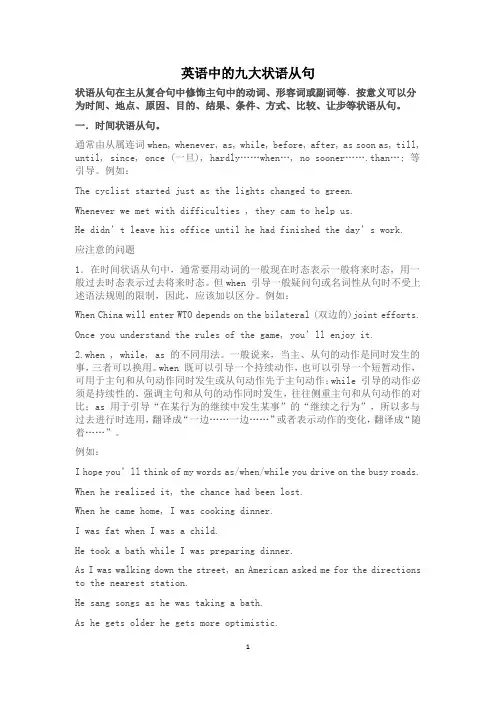
英语中的九大状语从句状语从句在主从复合句中修饰主句中的动词、形容词或副词等,按意义可以分为时间、地点、原因、目的、结果、条件、方式、比较、让步等状语从句。
一.时间状语从句。
通常由从属连词when, whenever, as, while, before, after, as soon as, till, until, since, once (一旦), hardly……when…, no sooner…….than…; 等引导。
例如:The cyclist started just as the lights changed to green.Whenever we met with difficulties , they cam to help us.He didn’t leave his office until he had finished the day’s work.应注意的问题1.在时间状语从句中,通常要用动词的一般现在时态表示一般将来时态,用一般过去时态表示过去将来时态。
但when 引导一般疑问句或名词性从句时不受上述语法规则的限制,因此,应该加以区分。
例如:When China will enter WTO depends on the bilateral (双边的)joint efforts.Once you understand the rules of the game, you’ll enjoy it.2.when , while, as 的不同用法。
一般说来,当主、从句的动作是同时发生的事,三者可以换用。
when 既可以引导一个持续动作,也可以引导一个短暂动作,可用于主句和从句动作同时发生或从句动作先于主句动作;while 引导的动作必须是持续性的,强调主句和从句的动作同时发生,往往侧重主句和从句动作的对比;as 用于引导“在某行为的继续中发生某事”的“继续之行为”,所以多与过去进行时连用,翻译成“一边……一边……”或者表示动作的变化,翻译成“随着……”。
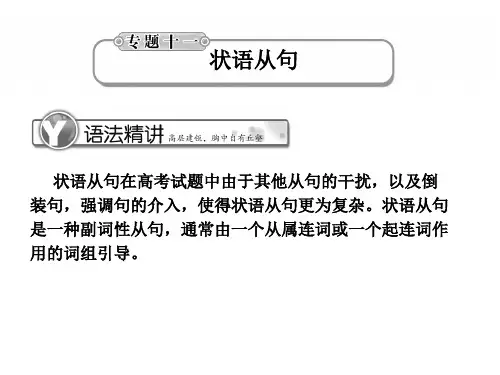
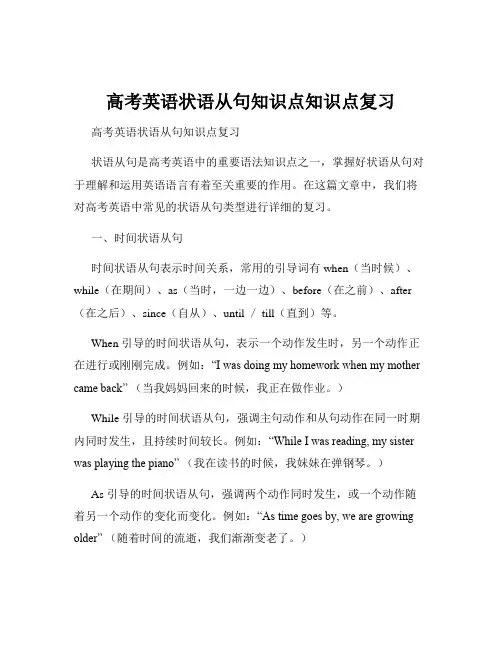
高考英语状语从句知识点知识点复习高考英语状语从句知识点复习状语从句是高考英语中的重要语法知识点之一,掌握好状语从句对于理解和运用英语语言有着至关重要的作用。
在这篇文章中,我们将对高考英语中常见的状语从句类型进行详细的复习。
一、时间状语从句时间状语从句表示时间关系,常用的引导词有 when(当时候)、while(在期间)、as(当时,一边一边)、before(在之前)、after (在之后)、since(自从)、until / till(直到)等。
When 引导的时间状语从句,表示一个动作发生时,另一个动作正在进行或刚刚完成。
例如:“I was doing my homework when my mother came back” (当我妈妈回来的时候,我正在做作业。
)While 引导的时间状语从句,强调主句动作和从句动作在同一时期内同时发生,且持续时间较长。
例如:“While I was reading, my sister was playing the piano” (我在读书的时候,我妹妹在弹钢琴。
)As 引导的时间状语从句,强调两个动作同时发生,或一个动作随着另一个动作的变化而变化。
例如:“As time goes by, we are growing older” (随着时间的流逝,我们渐渐变老了。
)Before 和 after 引导的时间状语从句,分别表示“在之前”和“在之后”。
例如:“Please turn off the light before you leave the room” (在你离开房间之前,请关灯。
)“I will call you after I finish my work” (我完成工作之后会给你打电话。
)Since 引导的时间状语从句,表示“自从以来”,主句通常用现在完成时,从句用一般过去时。
例如:“I have lived here since I was born”(自从我出生以来,我就住在这里。

语法复习六:状语从句由从句担任的状语,在句子中可修饰谓语(或其它动词)、形容词、副词或是整个句子,它可以用来表示时间、地点、原因、目的、结果、条件、方式、比较、让步等。
状语从句是一较大的语法项目,也是近几年高考题中常见的一个重要试点。
高考中已考查了时间、让步、地点、条件、目的等状语从句,这些从句仍是今后高考热点,应作充分准备。
同时对方式状语从句也应引起重视。
(一)时间状语从句表示时间的状语从句可由when, as, while, whenever, after, before, till (until), since, once, as soon as (或the moment ), by the time, no sooner … than, hardly (scarcely) … when, every time等引导。
e.g. When I came into the office, the teachers were having a meeting.He started as soon as he received the news.Once you see him, you will never forget him.No sooner had I gone to bed than I went to sleep.(二)原因状语从句原因状语从句是表示原因或理由的,引导这类从句的最常用的连词是because, since, as , now that(既然)等,for 表示因果关系时(它引导的不是从句)为并列连词,语气不如because 强。
e.g. He is disappointed because he didn't get the position.As it is raining, I will not go out.Now that you mention it, I do remember.(三)地点状语从句引导地点状语从句的连词是where 和wherever等。
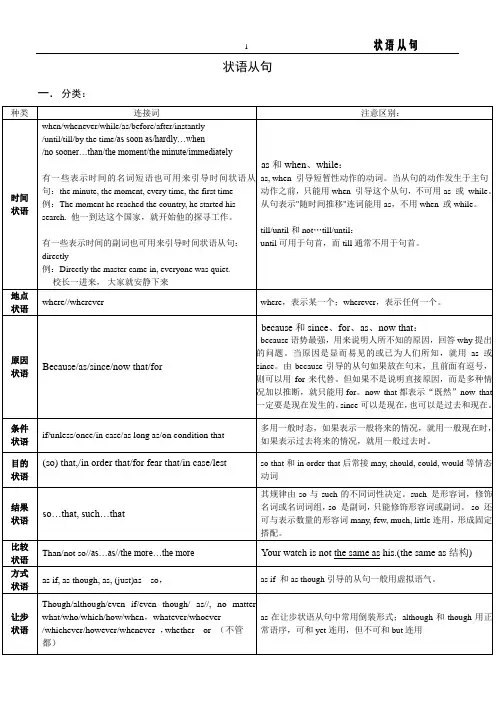
状语从句一.分类:when (当……的时候) while (在……期间) as (当……的时候, 一边……一边……)before (在……之前) since (自从……以来) till/until (直到) hardly…when… (刚……就) as soon as (一……就……)after (在……之后) not…till/until(直到……才)no sooner…than…(刚……就) 地点状语从句:where (在那里) wherever(无论哪里)原因状语从句:because (因为) since (因为,既然) as (由于) for (为了) now that(既然)目的状语从句:(so)that=in order that(以便)so as(not)to (以便[不])in case(以免)lest(以免)结果状语从句:so+adj./adv.+that(如此……以致)so that(结果……)such+n.+that(如果……以致)that(所以,因此)让步状语从句:though/although不可同but连用。
though/although (虽然)however (可是)even though/if(即使)no matter+what/which/where/who/when =whatever/whichever/wherever/whoever/whenever(不论什么/哪一个/哪里/谁/何时)比较状语从句:as (正如)as…as(和……一样)not as/so … as (不如……)than(比……更)the+比较级…+the+比较级(越……越……)条件状语从句:if(假设)unless(如果不)so long as(只要)on condition that (如果)方式状语从句:as(像……那样地)just as(正像)as if(好像)as though(好像)二.各种状语从句的简化方法:1作状语。
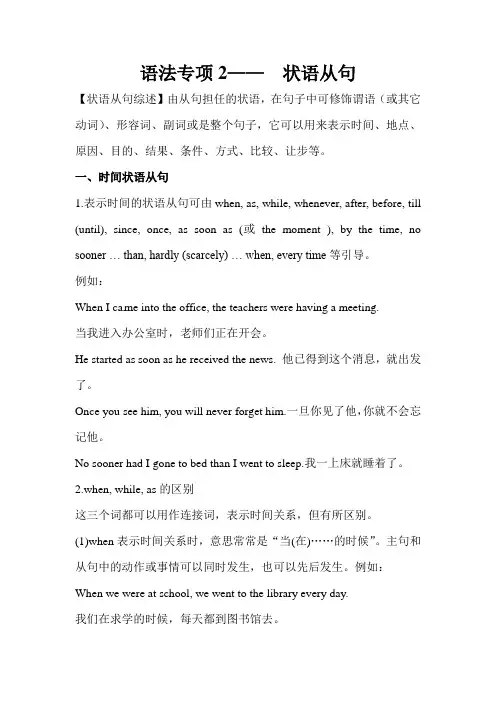
语法专项2——状语从句【状语从句综述】由从句担任的状语,在句子中可修饰谓语(或其它动词)、形容词、副词或是整个句子,它可以用来表示时间、地点、原因、目的、结果、条件、方式、比较、让步等。
一、时间状语从句1.表示时间的状语从句可由when, as, while, whenever, after, before, till (until), since, once, as soon as (或the moment ), by the time, no sooner … than, hardly (scarcely) … when, every time等引导。
例如:When I came into the office, the teachers were having a meeting.当我进入办公室时,老师们正在开会。
He started as soon as he received the news. 他已得到这个消息,就出发了。
Once you see him, you will never forget him.一旦你见了他,你就不会忘记他。
No sooner had I gone to bed than I went to sleep.我一上床就睡着了。
2.when, while, as的区别这三个词都可以用作连接词,表示时间关系,但有所区别。
(1)when表示时间关系时,意思常常是“当(在)……的时候”。
主句和从句中的动作或事情可以同时发生,也可以先后发生。
例如:When we were at school, we went to the library every day.我们在求学的时候,每天都到图书馆去。
(2)while 用作连接词表示时间关系时,意思也是“当(在)……的时候”,主句中的动作或事情在从句中的动作或事情的进展过程中发生。
它有时可与when通用,但它只能指一段时间(a period of time),而不能指一点时间的(a point of time)。
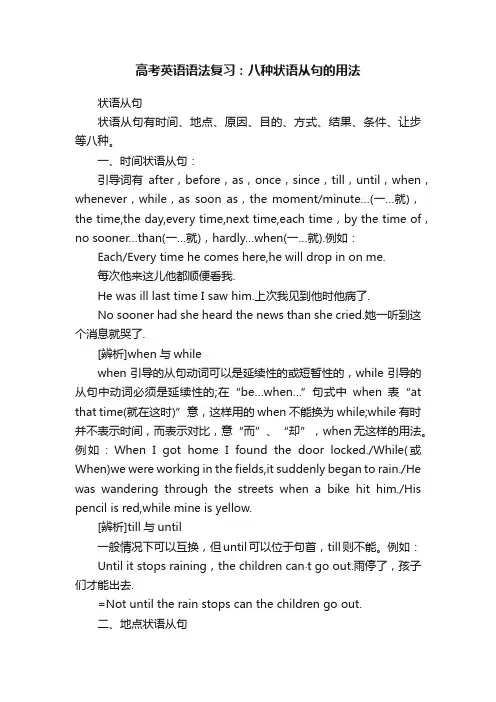
高考英语语法复习:八种状语从句的用法状语从句状语从句有时间、地点、原因、目的、方式、结果、条件、让步等八种。
一、时间状语从句:引导词有after,before,as,once,since,till,until,when,whenever,while,as soon as,the moment/minute…(一…就),the time,the day,every time,next time,each time,by the time of,no sooner…than(一…就),hardly…when(一…就).例如:Each/Every time he comes here,he will drop in on me.每次他来这儿他都顺便看我.He was ill last time I saw him.上次我见到他时他病了.No sooner had she heard the news than she cried.她一听到这个消息就哭了.[辨析]when与whilewhen引导的从句动词可以是延续性的或短暂性的,while引导的从句中动词必须是延续性的;在“be…when…”句式中when表“at that time(就在这时)”意,这样用的when不能换为while;while有时并不表示时间,而表示对比,意“而”、“却”,when无这样的用法。
例如:When I got home I found the door locked./While(或When)we were working in the fields,it suddenly began to rain./He was wandering through the streets when a bike hit him./His pencil is red,while mine is yellow.[辨析]till与until一般情况下可以互换,但until可以位于句首,till则不能。
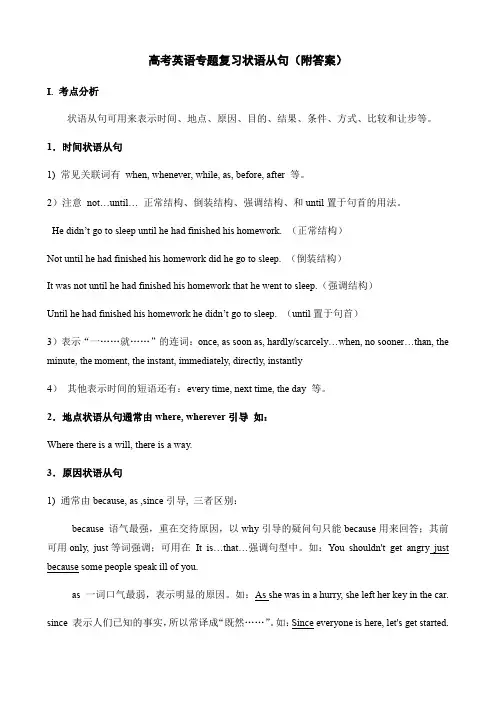
高考英语专题复习状语从句(附答案)I. 考点分析状语从句可用来表示时间、地点、原因、目的、结果、条件、方式、比较和让步等。
1.时间状语从句1) 常见关联词有when, whenever, while, as, before, after 等。
2)注意not…until… 正常结构、倒装结构、强调结构、和until置于句首的用法。
He didn’t go to sleep until he had finished his homework. (正常结构)Not until he had finished his homework did he go to sleep. (倒装结构)It was not until he had finished his homework that he went to sleep.(强调结构)Until he had finished his homework he didn’t go to sleep. (until置于句首)3)表示“一……就……”的连词:once, as soon as, hardly/scarcely…when, no sooner…than, the minute, the moment, the instant, immediately, directly, instantly4)其他表示时间的短语还有:every time, next time, the day 等。
2.地点状语从句通常由where, wherever引导如:Where there is a will, there is a way.3.原因状语从句1) 通常由because, as ,since引导, 三者区别:because 语气最强,重在交待原因,以why引导的疑问句只能because用来回答;其前可用only, just等词强调;可用在It is…that…强调句型中。
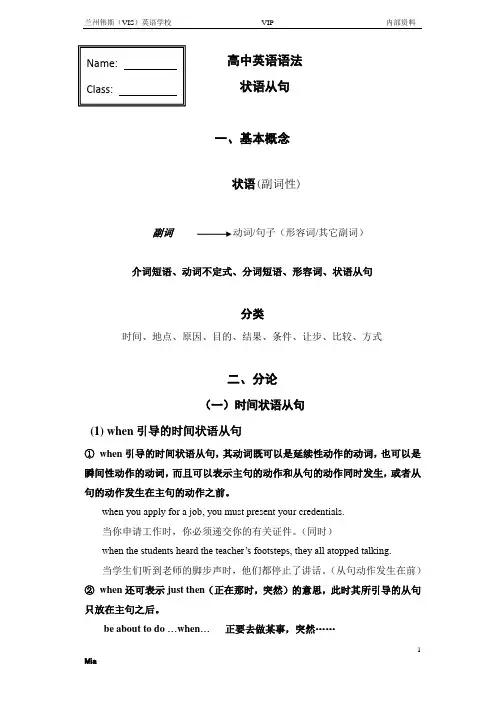
高中英语语法状语从句一、基本概念状语(副词性)副词 动词/句子(形容词/其它副词)介词短语、动词不定式、分词短语、形容词、状语从句分类时间、地点、原因、目的、结果、条件、让步、比较、方式二、分论(一)时间状语从句(1) when 引导的时间状语从句①when 引导的时间状语从句,其动词既可以是延续性动作的动词,也可以是瞬间性动作的动词,而且可以表示主句的动作和从句的动作同时发生,或者从句的动作发生在主句的动作之前。
when you apply for a job, you must present your credentials.当你申请工作时,你必须递交你的有关证件。
(同时)when the students heard the teacher’s footsteps, they all atopped talking.当学生们听到老师的脚步声时,他们都停止了讲话。
(从句动作发生在前) ② when 还可表示just then (正在那时,突然)的意思,此时其所引导的从句只放在主句之后。
be about to do …when … 正要去做某事,突然……be doing …when…正在做某事,突然……be on the point of doing …when…正在做某事,突然……We were about to start when it began to rain.我们正要动身,突然天下起雨来。
The game had hardly/scarcely/barely begun when it started raining.比赛刚刚开始就下起雨来。
(2) as引导的时间状语从句as引导的时间状语从句其动词的动作是延续性的,而且侧重表示主句和从句的动作交替或同时发生,译为“一边……,一边……”或“随着……”We were having breakfast as she was combing her hair.她梳头时我们在吃早饭。

高三英语复习:状语从句一、在主从复合句中修饰主句中的动词、形容词、副词等词的从句叫状语从句,也称副词性从句,一般可分为时间状语从句,地点状语从句,原因状语从句,目的状语从句,结果状语从句,条件状语从句,让步状语从句,比较状语从句和方式状语从句。
掌握状语从句的关键在于熟记各种组昂语从句的引导词。
二、时间状语从句:引导词有When, while, as, before, after, since, until/till, as soon as, once, each time, everytime, next time, the moment, the minute, immediately, instantly等。
1、When引导的时间状语从句:⑴When 意为“当......时候”,表示主句的动作和从句的动作同时或先后发生;When I was wandering in the street, I met her.Faith is the bird that feels the light when the dawn is still dark.Please tell him about it when you see him back.⑵When 引导的状语从句中的动词可用延续性,也可用终止性动词;He was listening to the music when I went in.I will visit my parents when I have time.All time is no time when it is past. 光阴一去不复返。
⑶对比:When 还可表示“突然性”,“如果”,“既然”;We were just about to leave when it began to rain.Turn off the switch when anything goes wrong with the machine.How can they learn anything when they spend all their time watching TV?2、While引导的时间状语从句:⑴While 表示“与……同时”,“在……期间”。
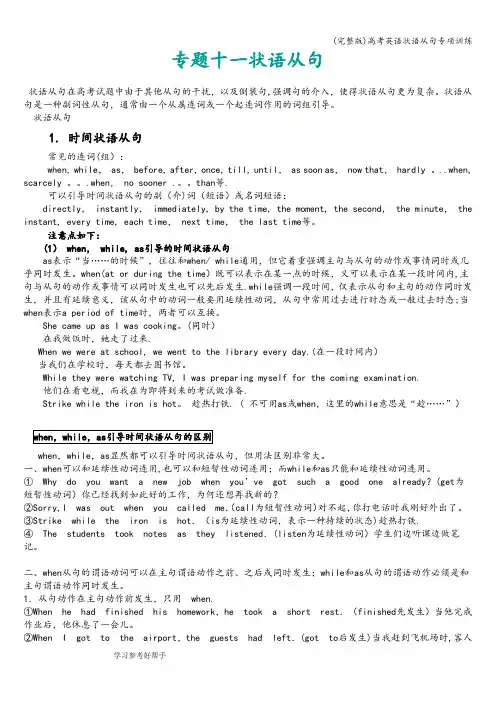
专题十一状语从句状语从句在高考试题中由于其他从句的干扰,以及倒装句,强调句的介入,使得状语从句更为复杂。
状语从句是一种副词性从句,通常由一个从属连词或一个起连词作用的词组引导。
状语从句1. 时间状语从句常见的连词(组):when, while, as, before, after, once, till, until, as soon as, now that, hardly 。
..when, scarcely 。
.when, no sooner .。
than等.可以引导时间状语从句的副(介)词(短语)或名词短语:directly, instantly, immediately, by the time, the moment, the second, the minute, the instant, every time, each time, next time, the last time等。
注意点如下:(1) when, while, as引导的时间状语从句as表示“当……的时候”,往往和when/ while通用,但它着重强调主句与从句的动作或事情同时或几乎同时发生。
when(at or during the time)既可以表示在某一点的时候,又可以表示在某一段时间内,主句与从句的动作或事情可以同时发生也可以先后发生.while强调一段时间,仅表示从句和主句的动作同时发生,并且有延续意义,该从句中的动词一般要用延续性动词,从句中常用过去进行时态或一般过去时态;当when表示a period of time时,两者可以互换。
She came up as I was cooking。
(同时)在我做饭时,她走了过来.When we were at school, we went to the library every day.(在一段时间内)当我们在学校时,每天都去图书馆。
While they were watching TV, I was preparing myself for the coming examination.他们在看电视,而我在为即将到来的考试做准备.Strike while the iron is hot。
高中英语语法:状语从句篇一、时间状语从句1、when的用法(1)when既可引导一个持续性动作,也可引导一个短暂性动作,可用于表示主句和从句动作同时发生或从句动作先于主句动作,有时还可表示从句动作后于主句,意为“当。
时候”。
(2)when在be about to do......when......,be doing.....when.....,had done。
when。
,be on one’s way。
when。
,be on the point of doing。
when。
等结构中,作“那时突然”讲。
(3)when “既然、鉴于;尽管,虽然(位于主句之后);如果”2、while的用法(1)表示“当。
时候”,引导的动作必须是延续性的。
(2)用作并列连词,表示相对关系“然而”。
(3)引导让步状语从句,相当于although,意为“虽然”,位于主句前。
(4)引导条件状语从句,相当于as/so long as,意为“只要”。
3、as 的用法(1)表示“当。
时候”,强调同时发生,不指先后。
(2)说明两种正在发展或变化的情况,表示“随着”,表示时间的推移。
(4)强调两个动作紧接着发生。
(5)表示“虽然,尽管”。
(6)其他含义“正如,正像”,“作为”,“由于,因为”。
4、before的用法(1)一般意为“在。
之前”“。
才”,“。
就”“还没有。
”“免得”“不知不觉”“宁可,宁愿”,“否则,要不然”。
(2)It + will be/was + 时间段+before+一般现在时/一般过去时。
在肯定句中,意为“多长时间之后才”;在否定句中,意为“用不了多长时间就”。
5、until和till(1)与肯定句连用,必须是延续性动词。
(2)与否定句连用,必须是非延续性动词,表示“直到。
才,在。
之前不。
”。
注意:not until可用于强调句和倒装句强调句:It is/was not until…that…倒装句:not until 放句首时,主句要部分倒装。
英语句型分析之状语从句(完整版)状语从句⽤来修饰主句中的动词,副词和形容词的从句叫状语从句。
时间状语从句 when, whenever, while, as, before, after, since, till, once, as soon as,etc.地点状语从句 where,wherever原因状语从句 because, since, as, for, now that, etc.⽬的状语从句 in order that, so that, that, etc.结果状语从句 so…that, so that, such…that, that, etc.条件状语从句 if, unless, as(so)long as, etc.让步状语从句 though, although, even if, even though, however, whatever, as,etc.⽐较状语从句 as…as, so…as, than, etc.⽅式状语从句 as, as if, as though, etc1. 时间状语从句(1)时间状语从句常⽤when, as, while, before, after, since, till, until, as soon as等连词来引导。
e.g.It was raining hard when got to school yesterday.e.g.After he finished middle school, he went to work in a factory.在时间状语从句⾥,通常不⽤将来时态,⽤现在时态表⽰将来的动作或状态。
e.g.I’ll ring you up as soon as I get to New York.在带有till或until引导的时间状语从句的主从复合句⾥,如果主句⽤肯定式,其含义是“⼀直到……时”,谓语动词只能⽤延续性动词。
状语从句定语:修饰名词,把名词“定住”I don’t like lazy people.I don’t like people who never keep their word.状语:修饰动作,把句子“壮大”九种状语从句:时间地点原因结果方式目的条件让步比较例:I love you ____ you love me.I love you when you love me.时间状语从句I love you where you love me.地点状语从句I love you because you love me.原因状语从句I love you so you love me.结果状语从句I love you as you love me.方式状语从句I love you in order that you love me.目的状语从句I love you if you love me.条件状语从句I love you even if you don’t love me.让步状语从句I love you more than you love me.比较状语从句一、时间状语从句【when, while , as(当)before, after, since, till, until ,as soon as, the minute, the moment,the instant,immediately, directly, no sooner...than… ,hardly...when…,scarcely...when… 】例:1.—What was the party like?—Wonderful. It’s yea rs _____ I enjoyed myself so much.A. afterB. beforeC. whenD. since2.It is/has been 50 years _____________the People’s Republic of China was founded.A. afterB. beforeC. whenD. since3._____ the sun rises, all the stars in the sky disappear.A. The momentB. BeforeC. TillD. For4.The new secretary is supposed to report to the manager as soon as she _______.A. will arriveB. arrivesC. is arrivingD. is going to arrive5.Remember to send me a photo of your son next time you _____ to me.A. writeB. will writeC. are writingD. would write6.________ I saw the computer, I showed great interest in it.A. At firstB. For the first timeC. UntilD. The first time7.Why do you want a new job _____ you got such a good one already?A. thatB. whereC. whichD. when答案1-7:DDABADD解析:时间、让步和条件等状语从句中可以用一般现在时表示一般将来时。